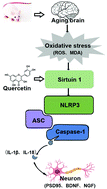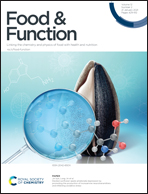Quercetin improves cognitive disorder in aging mice by inhibiting NLRP3 inflammasome activation
Abstract
Quercetin is one of the most abundant dietary flavonoid compounds, and its mechanism for combating age-related neurodegenerative diseases is unclear. In this study, quercetin (35 and 70 mg kg−1, orally administered for 4 weeks) was administered to 7-month-old aging mice (senescence-accelerated mouse prone 8 mice). As a result, it was found that quercetin could improve spatial learning and memory impairment displayed by aging mice in the Morris water maze. The results of immunoblotting reflected the protein expressions of the longevity factor (sirtuin1), inflammasomes (NLRP3 and ASC), synaptic marker (PSD95) and neurotrophic factors (BDNF and NGF) in the hippocampus of the brain. It indicated that the intervention of quercetin could increase the expression of sirtuin1 and prevent neuroinflammation, which was evident from the decrease in the protein levels of the astrocyte marker (GFAP) and inflammatory factors (cleaved-caspase 1, IL-1β and IL-18). In addition, quercetin could reduce the levels of malondialdehyde (MDA) and reactive oxygen species (ROS) in the hippocampus of aging mice. Current data indicated that quercetin might improve neuroinflammation in aging mice by regulating the Sirtuin1/NLRP3 pathway.



 Please wait while we load your content...
Please wait while we load your content...